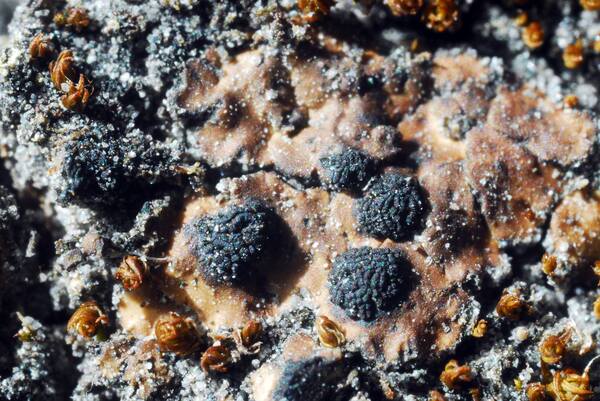Opegrapha placidiicola (Zhurb.) Nav.-Ros. & Romero
Bull. Soc. linn. Provence, 71: 96, 2020.. Basionym: Opegrapha pulvinata Rehm var. placidiicola Zhurb., - Opuscula Philolichenum,, 7 : 144, 2009.
Synonyms:
Distribution: S - Cal (Puntillo 1996 fide Navarro Rosinés & Romero 2020).
Description: Thallus not lichenized, parasitic on Placidium-species. Apothecia lirelliform, black, sessile, more or less round, up to 0.35 mm across, isolated or forming up to 1.5 mm wide groups, with a poorly evident, slit-like disc and a raised, 50-80 μm thick, often flexuose proper margin. Proper exciple dark brown to black, pseudoparenchymatous, extending below the hymenium, 30-100 μm thick laterally, 20-50 μm thick at the base; epithecium pale brown, 10–20 μm high; hymenium colourless, 80–90 μm high, I+ orange-red, K/I+ blue; paraphysoids branched and anastomosing, 2–2,5 μm thick, the apical cells not or only slightly swollen, up to 3,5 μm wide; subhymenium and hypothecium colourless to pale brown, c. 20 μm high. Asci 4-6-spored, broadly club-shaped, the inner layer of endoascus amyloid in upper part, with a reduced ring and ocular chamber (varia-type). Ascospores (2-)3-septate, constricted at septa, hyaline but turning pale brown when overmature, narrowly ellipsoid to clavate, straight, (11-)16-19(-21) x (4.5-)6–7(-7.5) μm, with a granulose perispore at maturity. Pycnidia dark brown, subglobose, immersed. Conidia simple, hyaline, narrowly oblong to ellipsoid, 2,5– 4 x 1–1,5 μm. Photobiont absent. Spot tests: K-, C-, KC-, P-, UV-. Chemistry: without lichen substances.Note: a recently-described lichenicolous fungus growing on the squamules of Placidium-species, probably more widespread in Mediterranean Italy.
Growth form: Lichenicolous fungus
Substrata: soil, terricolous mosses, and plant debris
Reproductive strategy: mainly sexual
paras Placidium-species
Commonnes-rarity: (info)
Alpine belt: absent
Subalpine belt: absent
Oromediterranean belt: absent
Montane belt: absent
Submediterranean belt: extremely rare
Padanian area: absent
Humid submediterranean belt: extremely rare
Humid mediterranean belt: extremely rare
Dry mediterranean belt: extremely rare

Predictive model
Growth form: Lichenicolous fungus
Substrata: soil, terricolous mosses, and plant debris
Reproductive strategy: mainly sexual
paras Placidium-species
Commonnes-rarity: (info)
Alpine belt: absent
Subalpine belt: absent
Oromediterranean belt: absent
Montane belt: absent
Submediterranean belt: extremely rare
Padanian area: absent
Humid submediterranean belt: extremely rare
Humid mediterranean belt: extremely rare
Dry mediterranean belt: extremely rare

Predictive model


